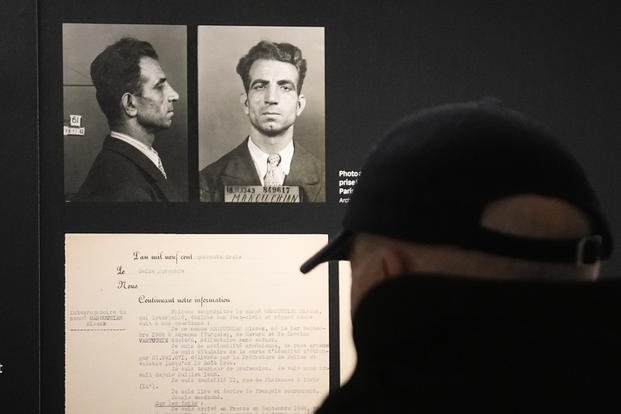PARIS — While France hosts grandiose ceremonies commemorating D-Day, Missak Manouchian and his Resistance fighters’ heroic role in World War II are often overlooked. French President Emmanuel Macron is seeking to change that by inducting Manouchian into the Panthéon national monument on Wednesday.
A poet who took refuge in France after surviving the Armenian genocide, Manouchian was executed in 1944 for leading the resistance to Nazi occupation. Macron is to lead a Paris ceremony in homage to Manouchian at the Panthéon, the resting place of France's most revered figures, in the presence of Armenian Prime Minister Nikol Pashinyan.
The tribute will also include members of his Resistance group.
“With them, it’s all foreign Resistance fighters who enter into the Panthéon,” said historian Denis Peschanski, who led efforts to honor Manouchian's memory.
The move comes as France gets ready to celebrate the 80th anniversary of D-Day this year in the presence of heads of states and World War II veterans.
Manouchian’s coffin, covered with the French flag, will be carried in the street in front of the Panthéon by soldiers of the Foreign Legion.
On Tuesday, a homage was being held at Mont Valérien, where Manouchian and his group members were shot by the Nazis. The site has become a memorial to French WWII fighters. The Holocaust Memorial in Paris was also holding an exhibit in his honor.
“Missak Manouchian chose France twice, first as a young Armenian who loved Baudelaire and Victor Hugo, and then through the blood he shed for our country,” the French presidency said in a statement last year announcing the Panthéon homage.
Born in 1906 in the then-Ottoman empire, Manouchian lost both his parents during the genocide of 1.5 million Armenians by Ottoman Turks in 2015-2016.
He was sent to an orphanage in Lebanon, then a French protectorate, where he discovered French language and culture.
He came to France in 1924. Living in Paris, he wrote poetry and took literature and philosophy classes at the Sorbonne University — while working in factories and doing other odd jobs.
He joined the communist party in the early 1930s within the MOI (Immigrant Workforce Movement) group and became editor-in-chief of a newspaper for the Armenian community.
During World War II, he joined the French Resistance as a political activist with the then-underground MOI group.
In 1943, he became a military chief in the armed organization of the communist party, the FTP-MOI group of about 60 Resistance fighters that gathered many foreigners from Armenia, Hungary, Poland, Romania, Bulgaria, Italy and Spain, including many Jewish people.
Manouchian is the first foreign and first communist Resistance fighter to be inducted into the Panthéon, Peschanski noted.
His group led dozens of anti-Nazi attacks and sabotage operations in and around Paris between August and November 1943, including the assassination of a top German colonel.
Tracked down by the French police of the Vichy regime that collaborated with Nazi Germany, Manouchian was arrested on Nov. 16, 1943 along with most of the group’s members. He was sentenced to death in Feb. 1944.
Nazi propaganda officers ordered a poster to be made with the photos and names of 10 Resistance fighters, including Manouchian, displayed in Paris and other French cities.
The so-called Red Poster sought to discredit them as Jews, foreigners and criminals, and Manouchian was "obviously the first target," Peschanski said. Yet the campaign didn't convince the French population, he said: The poster, while “aiming at presenting them as assassins, made them heroes.”
In his last letter to his wife, Mélinée, Manouchian wrote : “At the moment of death, I proclaim that I have no hatred for the German people ... The German people, and all other people will leave in peace and brotherhood after the war.”
French poet Louis Aragon wrote a poem in 1955 inspired by the letter that singer Léo Ferré set to music under the title “L’Affiche Rouge” ("The Red Poster"), keeping the memory alive and making the song a French standard.
Mélinée, also a member of the Resistance who survived the war, will be buried alongside her husband at the Panthéon. A commemorative plaque will pay tribute to the other members of the Manouchian group.
Recent research about Manouchian also brought to light the fact that dozens of the 185 foreigners shot to death by the Nazis at Mont Valérien had not been officially declared “Morts pour la France” ("Dead for France") — "mostly because they were foreigners," Peschanski noted. The French presidency said the issue was addressed last year to give them the honor.
The Panthéon is the resting place of 83 people — 76 men and seven women — including Manouchian and his wife.
Most recently, Josephine Baker — the U.S.-born entertainer, anti-Nazi spy and civil rights activist became the first Black woman to receive France's highest honor, in 2021.












